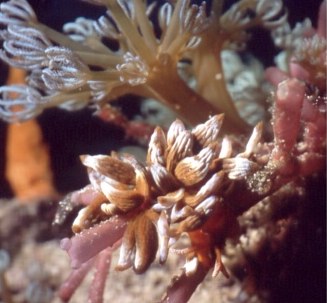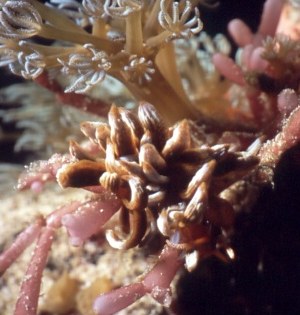Phyllodesmium kabiranum by Todd Garthwaite
April 6, 2002
From: Todd Garthwaite


Hi Bill,
Here are two shots of (what is probably) Phyllodesmium kabiranum, which I came across in an area strewn with rocks, rubble, ship-wreck timber, sand, and small patches of soft coral, at "the 1st wreck", (which was an old wooden Chinese junk), at a dive site called Sabang Wrecks just offshore from Sabang, Puerto Galera, the Philippines.
Date: 17 January 2002
Depth: 18.7 meters
Temp: 23 degrees C.
Size: approx. 38mm.
This particular nudibranch possesses an interesting form of camouflage, as well as what appears to be a voracious appetite for soft coral. (Incidentally, what is the scientific name for this particular species of coral that Phyllodesmium kabiranum feeds on?
Stay golden.
Todd Garthwaite
(Taipei, Taiwan)
typhoontoddy@yahoo.com
Garthwaite, T., 2002 (Apr 6) Phyllodesmium kabiranum by Todd Garthwaite. [Message in] Sea Slug Forum. Australian Museum, Sydney. Available from http://www.seaslugforum.net/find/6510Dear Todd,
This is an interesting find. Most species of Phyllodesmium feed on soft corals and in association with this diet have evolved some unique features. If you have a look at the other species on the Forum you will see this fedding habit has allowed a whole radiation of shapes and sizes in their evolution.
The two most interesting points is that the nematocyst stinging cells in soft-corals are too small to be of much use in the nudibranch defence so they don't have the usual aeolid cnidosac at the tip of each ceras. Instead they can readily autotomise [break off] their cerata which produce a sticky secretion to confuse potential predators. Their other claim to fame is stealing microscopic plants called zooxanthellae from the soft corals they are feeding on. They keep these alive in their tissues where they produce nutrients for the slugs. [see the pages on Solar Powered Sea Slugs].
To your question about the soft coral your animal is feeding on. Firstly this is probably the first observation of it feeding on a soft coral so thanks very much. As to the identity of the soft coral I am not sure It looks like a Xenia or close relative, aand hopefully someone will be able to identify it for us. If you have a photo showing more of the soft coral colony it might be useful in getting it identified.
Best wishes,
Bill Rudman
Related messages
-
Phyllodesmium kabiranum from Derawan, Borneo, Indonesia
From: Carrie Lo, June 6, 2007 -
Phyllodesmium kabiranum from Lembeh
From: Bruce Wight, February 17, 2007 -
Phyllodesmium kabiranum from Palawan, Philippines
From: Michael Jimenez, February 17, 2007 -
Phyllodesmium from North Sulawesi
From: Indra Swari, February 17, 2007 -
Phyllodesmium kabiranum from Malaysia
From: Mike Krampf, February 17, 2007 -
Phyllodesmium kabiranum laying eggs
From: Mary Jane Adams, October 19, 2005 -
Phyllodesmium kabiranum from Lembeh Strait
From: Mary Jane Adams , December 8, 2002 -
Re: Phyllodesmium kabiranum from Komodo
From: Dave Behrens, September 6, 2002 -
Re: Phyllodesmium kabiranum from Komodo
From: Walabha Sinbul, September 5, 2002 -
Phyllodesmium kabiranum from Komodo
From: Walabha Sinbul, August 16, 2002
